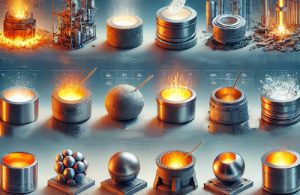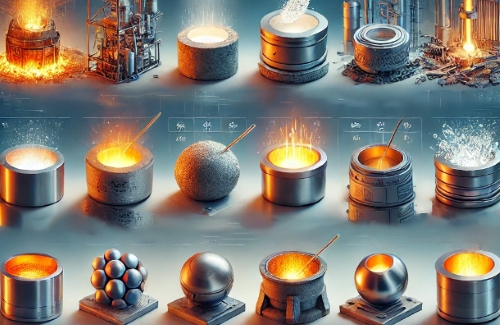Introduction
Heat-resistant crucibles are essential tools used in various industrial and laboratory processes, designed to withstand extremely high temperatures without melting, deforming, or breaking down. Here are some of the most common types of heat-resistant crucibles, ranked by their temperature resistance, along with their characteristics and applications:

1. Tungsten Crucibles
Tungsten crucibles can withstand temperatures up to 3,422°C (6,192°F), making them the most heat-resistant crucibles available. They exhibit excellent resistance to thermal shock and oxidation at high temperatures. Tungsten crucibles are widely used in applications such as crystal growth, superalloy production, and in high-temperature furnaces, particularly in the aerospace and defense industries.
Related reading: What Material is a Crucible Made of?
2. Zirconia Crucibles
Zirconia crucibles are capable of withstanding temperatures up to 2,700°C (4,892°F). They are highly resistant to thermal shock and chemical attack, particularly in environments involving strong acids and alkalis. Zirconia crucibles are used in the melting of high-temperature alloys, the production of specialty glasses, and chemical processing where aggressive environments are involved.
3. Silicon Carbide Crucibles
Silicon carbide crucibles can endure temperatures up to 2,500°C (4,532°F). They are known for their durability, resistance to thermal shock, oxidation, and chemical corrosion, as well as their high thermal conductivity. These crucibles are commonly used in metal melting, especially for non-ferrous metals like aluminum and copper, and are also important in the ceramics industry and high-temperature furnaces.
4. Molybdenum Crucibles
Molybdenum crucibles can tolerate temperatures up to 2,623°C (4,753°F). They offer good thermal conductivity, resistance to thermal shock, and corrosion resistance against many acids and alkalis. Molybdenum crucibles are employed in the production of semiconductors, the growth of single crystals, and the melting and casting of non-ferrous metals like titanium and zirconium.
5. Alumina Crucibles
Alumina crucibles are capable of withstanding temperatures up to 1,900°C (3,452°F). They are chemically inert, highly resistant to wear and corrosion, and suitable for a wide range of high-temperature applications. Alumina crucibles are often used in high-temperature chemical reactions, materials testing, and the synthesis of ceramics and glass.
6. Platinum Crucibles
Platinum crucibles can handle temperatures up to 1,800°C (3,272°F) and are highly resistant to oxidation and corrosion. Platinum’s chemical inertness makes these crucibles ideal for processes that require high purity and resistance to reactive substances. Platinum crucibles are commonly used in laboratories for high-temperature chemical reactions, mineral and ore analysis, and the production of high-purity materials.
7. Graphite Crucibles
Graphite crucibles have high thermal conductivity and are resistant to thermal shock, capable of withstanding temperatures up to around 3,000°C (5,432°F). They are also resistant to many chemicals, making them suitable for use with reactive metals and alloys. Graphite crucibles are frequently used in the melting of metals such as gold, silver, and aluminum, as well as in the production of high-purity materials and in chemical processing.
| Crucible Type | Maximum
Temperature |
Key Characteristics |
| Tungsten Crucibles | 3,422°C
(6,192°F) |
Highest heat resistance,
excellent thermal shock resistance |
| Graphite Crucibles | ~3,000°C
(5,432°F) |
High thermal conductivity,
chemical resistance |
| Zirconia Crucibles | 2,700°C
(4,892°F) |
High resistance
to thermal shock and chemical attack |
| Molybdenum Crucibles | 2,623°C
(4,753°F) |
Good thermal
conductivity, corrosion resistance |
| Silicon Carbide
Crucibles |
2,500°C
(4,532°F) |
Durable, resistant
to thermal shock and chemical corrosion |
| Alumina Crucibles | 1,900°C
(3,452°F) |
Chemically inert,
resistant to wear and corrosion |
| Platinum Crucibles | 1,800°C
(3,272°F) |
High oxidation and
corrosion resistance, chemical inertness |
Conclusion
In summary, the selection of an appropriate heat-resistant crucible depends on the specific requirements of the process, including the maximum temperature, the chemical environment, and the need for thermal shock resistance.
Crucibles made from materials like tungsten, molybdenum, silicon carbide, zirconia, and alumina are critical tools in industries ranging from metallurgy and electronics to chemical processing and materials science. Their ability to maintain structural integrity and resist chemical attack at high temperatures makes them indispensable in high-temperature applications. For more information, please check Advanced Refractory Metals (ARM).
